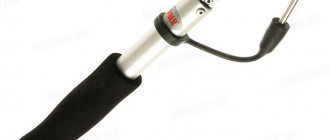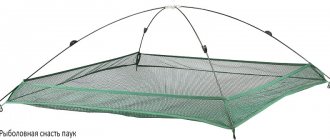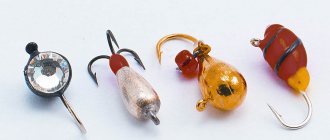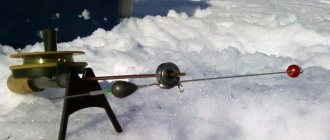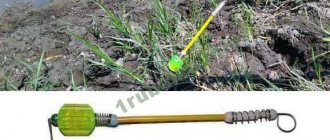The important advantages of fishing with bottom gear are the low rate of fishing and the ability to use several rods at the same time. Upon arrival at the reservoir, a convenient place for fishing is selected and donks are thrown throughout the sector in different directions.
If floaters or spinning anglers constantly monitor the condition of the gear and instantly notice a bite, then bottom fishers use a special device for effective fishing - a bite alarm for a bottom fishing rod.
Only when using feeder gear, the quivertip acts as a signaling device - a flexible tip of the rod that bends when the fishing line is pulled and thus signals that the fish has taken the bait. In such a case, constant visual control of the gear is necessary, and this limits the fisherman’s capabilities.
Even for an experienced fisherman, controlling two feeder rods is quite difficult, and using more rods is even more inconvenient. Using signaling devices for fishing with classic donks makes it possible to fish with 3 or more rods, and always be aware of what is happening with the gear.
Even when fishing with self-tapping rigs, the angler needs to react in time to the actions of the fish and, in order to avoid the tackle breaking, take the rod in his hands and place the trophy in the landing net.
What types of alarms are there?
The popularity of bottom fishing has given impetus to the creation of many different alarms, but they are all divided into three groups:
- visual;
- sound;
- combined.
Visual alarms are put on the fishing line and at the moment of a bite they change their position, notifying the angler that the fish has taken the bait. The use of such guards forces you to constantly be on alert and keep your gear in sight.
This is not always convenient, especially if the session takes place in the evening or at night, when visibility is minimal. On the other hand, purchasing visual alarms such as bells or bells does not require serious financial investments.
If we take into account that bottom fishing is carried out using 4-5 rods at once, the money savings are even more significant. But bells or bells are classified as mechanical signaling devices of a combined type because, in addition to visual information, they also provide an audible signal.
Being in close proximity to his bottom gear, thanks to such guards it is easier for the fisherman to respond to a bite in a timely manner and hook the fish without letting it get off the hook.
When fishing in reservoirs with extremely cautious fish, sound alarms are not always effective and can even scare away fish that come close to the shore.
Therefore, the choice of signaling device for donkey depends on:
- conditions on the reservoir;
- the number of donks used;
- time of day when fishing is carried out;
- financial capabilities of the fisherman.
Every bottom fishing enthusiast has different types of alarms in their arsenal, but the decision about which ones to use is made upon arrival for fishing.
When fishing with hooks or donks with a rubber shock absorber, primitive guards of the mechanical type with visual control of the gear are used. They are made with your own hands from scrap materials, and this allows you to save on buying store-bought alarms.
Important! When fishing conditions change, the wind increases or the weather worsens, the indicators on the fishing line are often changed, selecting the most suitable option. In a strong wind, the same bells will constantly ring and mislead the angler waiting for a bite. In such cases, it is more convenient to use “fireflies”, which do not signal a “false alarm” and are triggered only when the fishing line is pulled by a fish.
Specifics of nods and their types
The same thing is a guard for a bottom fishing rod; there are no fundamental differences in its operation. It is a plate (or wire) made of flexible material, with a ring for fishing line at the end. Sometimes elastic components are not required. They are also made from coiled springs of varying stiffness. The nods are painted with a bright reflective varnish of green, red or yellow so that the angler can see the fact of the bite from afar. Sometimes additional sound alarms are hung on them, for example, small bells. This is a good help for those fishermen who cannot constantly look at the gear.
Lodges are used for both winter and summer fishing. They have four types:
- soft nods,
- intermediate (medium hardness),
- hard alarms,
- heavy guards.
The first type is used on lakes, ponds, backwaters and other bodies of water where there is no current. Suitable for catching any type of fish. The second type should be used on quiet rivers. The rigid nod copes with its task both in places with strong currents and during windy conditions. The latter type of alarms is used for deep (from five meters) fishing, including with live bait.
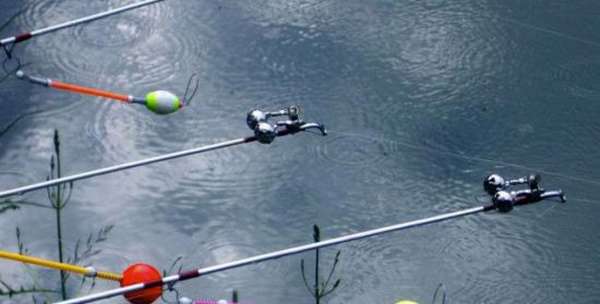
Rods with rotating and sound alarms The first three types of nods are not suitable for fishing with live bait: the alarm will react to it in the same way as to the catch.
It is best to place a hard or heavy plate guard on the bottom (depending on the depth and the target fish). For the feeder, spring devices are needed, because they do not imitate a bite during waves or wind. They are used mainly for winter fishing.
Experienced fishermen advise bending the feeder nod spring down slightly so that the alarm does not react even to increased water vibrations.
Based on functionality, nods can be divided into the following groups:
- bendable,
- rotating (inflexible),
- sound,
- with automatic cutting,
- combined (when one device includes several characteristics).
Bendable guards bend when signaling a bite down, rotating guards rotate, and sound guards ring. Self-hooking alarms work like this: the fish pulls the bait towards itself, the mechanism is triggered, sharply pulling the line towards the fisherman.
Designs of signaling devices for donka
According to the principle of operation, the gatehouse on the donka can be:
- mechanical;
- electronic.
Mechanical gatehouses
Mechanical alarms have a long history, because they were used by our grandfathers and great-grandfathers, who preferred calm and measured fishing with bottom gear. The designs of such gatehouses are very simple and this helps to increase their reliability.
The mechanical alarm does not require an additional battery to operate, and this is an important advantage. When fishing, there are situations when the guard gets wet in the rain, and the simpler its design, the higher its performance. The mechanical alarm is fixed directly on the fishing line and when its position changes, it gives a corresponding signal.
After the bite, the fisherman makes a hook, and the guard flies off the line, without creating obstacles when landing fish. This is convenient, but you have to tie the guard to the stand so that during a sharp hooking it does not fly into the water or get lost in the coastal grass.
Electronic devices

Electronic alarms appeared no more than ten years ago and use an additional power source, battery or battery. Electronic devices are more convenient to use, but their cost is much higher than their mechanical counterparts.
In addition, to ensure the functionality of such a gatehouse, not only a signaling device is needed, but also a swinger, or baht. After casting the donkey, the angler sets it so that the main line rests on the guard roller.
Swingers or bats are needed to ensure that the fishing line is pressed against the alarm roller, and at the slightest movement of the fishing line, the electronic alarm system is triggered.
The swingers are fixed on a bar, and the bats are on a chain; otherwise, their designs and functions are completely the same. The swinger bar is more stable in crosswinds and prevents false triggers. But the baht chain also has its own advantages; it increases the sensitivity of the design.

To ensure the reliability of the bat, a strong but flexible chain is selected, which is not afraid of the loads that arise when the rod is swung sharply while hooking a fish.
Important! To avoid any problems while fishing with electronic alarms, the angler must have spare batteries or batteries.
A nod for a summer side fishing rod with your own hands, how to make a guard for a bottom fishing rod and a winter fishing rod
Mechanical sound bite alarms are the most common. Such devices are distinguished by their simple design and low cost; many fishermen make them themselves from improvised means - various metal tubes, spent cartridges.
There are a lot of options for attaching bells and bells to the feeder. In the simplest version, the bell is simply hung closer to the tip of the rod, but such a feeder guard has a number of disadvantages.
However, this type of signaling device for the feeder is extremely inconvenient, especially in the case of biting and fishing - the bell can either stop the line or simply get lost during fishing. A more convenient option would be to install a bell on a rubber band.
The harness is attached to the rod stand, and a hook is attached to the bell, with which it will come into contact with the cord or fishing line. When a bite occurs, the line tightens and the bell begins to ring.
The bell does not get lost and does not fly off when casting, since the signaling device is installed after casting.
For donks, you can assemble a signaling device from improvised means, for example, from foil. Although such donkey guards are not particularly sensitive, in the absence of other indicators this can also be used.
Any foil is suitable for making an alarm - from chocolate wrappers, cigarette packs, etc. The foil is twisted into a tube around the main fishing line; it is desirable that the tube is at an angle of about 45 degrees in relation to the rod blank.
Using side nods and pendulum indicators
The side nod for the feeder is used in the same way as for the donkey. Such bite alarms for donkeys have become more widespread than for feeders, since the sensitivity of the feeder tip is still higher than that of this design.
The side nod is a metal rod, which at one end is attached to the form of the feeder rod by means of a special clamp, and the fishing line clings to the other end. When biting, the tip is pulled towards the form.
Such a device is especially effective for displaying bites during strong waves on a pond. This type of side bite alarm for the feeder is less sensitive than the quivertip rod, but in certain conditions its use may be justified.
In fishing stores you can find a light and sound alarm for every taste and budget. Electronic alarms for the most part detect a bite based on changes in the tension of the main fishing line.
Such devices can notify about a bite either by a light signal, or by sound, or by both methods at the same time. A number of devices signal a bite to the shore and a bite from the shore in different ways, which allows you to figure out what is happening as soon as you approach the rod rack.
The following requirements apply to electronic bite alarms for feeders:
- Such an indicator should be easy to adjust in conditions of poor visibility, at night, with wet hands. The convenience of the controls is an important factor; many anglers prefer models with toggle switches and switches rather than buttons.
- The set must have convenient packaging for transporting all parts.
- Low energy consumption. Since fishing trips can last more than one day, the energy consumption of such devices should be low, since there will be nothing to charge the batteries with. Car owners do not suffer from this problem, since most electronic indicators can be charged from the cigarette lighter.
- The device must have a waterproof case, since near bodies of water, electronic circuits, even without rain, are constantly threatened by high air humidity.
- It’s good if the signals when biting from the shore and towards the shore are significantly different.
Photo 3. Carp fishing alarms.
The electronic bite alarm for the feeder has the following advantages:
- Significantly greater sensitivity compared to mechanical options.
- Lower frequency of false alarms, since the sensitivity of the device can be adjusted for each body of water.
- The electronic board is able to recognize vibrations of the fishing line caused by wind or waves, which mechanical devices cannot do.
- Such devices allow you to accurately determine which rod the bite occurred on (if fishing is carried out with two or more feeder or bottom rods).
- The work is practically independent of weather conditions.
The principle of operation of the signaling device for bottom gear
Mechanical and electronic bite alarms work in a similar way. The device is attached directly to the main fishing line and records all its vibrations and pulls.
When a fish takes the bait on the hook, the line moves and its movements are transmitted to the indicator. The fisherman notices changes in the position of the indicator on the fishing line, and also hears a sound signal, makes a hook and brings the fish into the landing net.
Electronic devices better record bites “on the shore”, but in such cases the mechanical bell simply sags and there is no sound notification. When there is a side bite, the mechanical alarm is also ineffective and only if the fish’s pull is quite strong, the device will notify the fisherman about this.
The type of attachment of the alarm also plays a role, because when it is sharply hooked, it jumps off the fishing line and can fly into the water if it is not securely fastened. The electronic alarm is screwed to a post, which in turn is screwed to a wooden platform on the shore, or is inserted directly into the ground.
Even the strongest fish will not be able to pull out the stand and drag the alarm into the water. The swinger or bat, used to remove slack in the line, is also attached to the post using a chain or rod. After hooking, the swinger flies off the line, but remains hanging on the stand, so it’s difficult to lose it.
Classic signaling devices
However, it is still worth mentioning less technologically advanced signaling devices that perform their service no less effectively. You can learn how to make a donk from a spinning rod.

So here they are:
- Plumb weight. It works very effectively in reservoirs with weak currents or without it at all. It is suspended on a slightly slack fishing line near the peg on which all the bottom tackle is attached.
- Flexible rod tip. Perhaps the most sensitive bite alarm. The donka is equipped with a rod with the most sensitive tip, which must be bent by the tension of the fishing line. It is precisely by the vibration or deflection of the tip that even an extremely careful bite is visible. Such a signaling device is usually used in fast currents.

- Nod. If a short, rigid rod is used, then its top must be equipped with a sensitive nod, which, as a rule, is made of a steel strip or a twisted spring. A spring from an alarm clock would also work. For greater efficiency, such a nod can be painted in some bright color.
- Self-cutters. This know-how belongs to folk craftsmen who construct a structure from a series of springs. Having brought the self-cutters into working mode, they should be alerted with a stretched fishing line. When biting, the fishing line is pulled, which, in turn, activates the security mechanism. When triggered, it hooks the fish. Donks with such alarms can be installed at night and you can safely go to bed, and take your catch in the morning.
Advantages and disadvantages of electronic and mechanical alarms
Advantages of electronic signaling devices:
- reliable fastening both on a wooden platform and on the shore of a reservoir;
- light and sound bite indication;
- fixing bites both at depth and “on the shore”;
- high sensitivity;
- functionality;
- day and night operating modes.
The high sensitivity of electronic devices is especially important when catching large and cautious fish that bite carefully, carefully studying the bait on the hook.
When using a mechanical alarm, after the trophy has been bitten, there may be no sound warning and the fisherman has to carefully monitor the position of the gouge.
If fishing is carried out with 3-5 rods or even more, it is difficult for the fisherman to visually track the position of all the indicators, and if he misses a bite, he loses the fish. The electronic device records the slightest vibrations of the fishing line and is much more convenient when catching trophy fish.
But along with the advantages, electronic alarms also have disadvantages:
- high price;
- dependence on battery or accumulator;
- relative fragility.
Reputable manufacturers of fishing equipment produce electronic alarms with protection from moisture, sunlight and dust, but it is still not possible to completely prevent the negative impact. As a result, devices fail, and replacement with new ones will lead to additional costs.
This does not mean that electronic alarms should not be used; it is important to operate them in accordance with the manufacturer’s recommendations.
Electronic devices are mounted on:
- racks;
- genus-pods;
- buzz bars.
Such installation of guardhouses provides convenience for fishing and prevents their contamination.

Mechanical gatehouses
Mechanical signaling devices also have both advantages and disadvantages, which are taken into account when preparing for a fishing session.
Among the advantages of mechanical gatehouses we highlight:
- durability;
- unpretentiousness in maintenance;
- low cost;
- interchangeability;
- Possibility of use in any conditions.
When fishing for donkey from the shore or from a boat, mechanical alarms successfully cope with their functions, even if their sensitivity is lower than that of their electronic counterparts.
Even if you lose such a gatehouse, there is no need to be upset, because its cost is very low. In addition, fishermen have learned to make homemade mechanical bite alarms for bottom gear, thus minimizing fishing costs.
What are the requirements for bite alarms for donks?
Assessing the advantages and disadvantages of mechanical and electronic devices for registering bites, general requirements for such devices are formulated.
First of all, this:
- adequate cost;
- sensitivity under different weather conditions;
- water resistance;
- functionality;
- impact resistance;
- reliability;
- simple design.
It is difficult to find a signaling device that fully meets all the requirements, but there are models of quality that are as close to ideal as possible.
For the most part, the fisherman has to choose a lodge taking into account its advantages and disadvantages, corresponding to the fishing conditions on a particular body of water.
In this case, you have to sacrifice something, but this is not critical, the main thing is that the signaling device successfully performs its functions.
How to mount the alarm
Proper mounting of the alarm is important from the point of view of the sensitivity of this device and maintaining the fishing line in working condition. If the bells are attached to the tip of the rod using a plastic clothespin, which will not damage the blank, then the swingers or bats are attached directly to the fishing line and can damage it if handled carelessly.
Every fisherman has had cases when the main line broke off while fishing for a trophy, but not everyone knows that the cause of the break was damage to the base by the signal device. Therefore, you need to control the distance between the swinger’s antennae, by which it is attached to the fishing line, and, if necessary, make adjustments.
The swinger's antennae should not fit too tightly to each other, because in this case, damage to the fishing line occurs when putting on the guard. The distance between the antennae should be such that there is a maximum gap, but at the same time, the swinger is held on the fishing line.

The damage caused to the fishing line by tightly pulled tendrils is not visible at first glance, but if there is a strong pull, a break will occur and this usually happens at the most inopportune moment, when hooking a heavy fish. To avoid such troubles, check the condition of the swingers before each fishing trip.
Manufacturing of adjustable nods
The order is:
- We take a long clamp and put a piece (3-4 cm) of a durable rubber tube or insulator on it.
- We knock out the latch, as we have already described.
- We paint and wait for the varnish to dry. We hang a bell.
- We also attach the clamp together with the attached tube to the fishing rod.
- We melt the back of the guard a little with a lighter and bend it so that it does not fly forward.
- Let's check. The nod should not move freely back and forth.
The signaling device with adjustable hardness is ready. Its cost will not even be 15 rubles, it looks beautiful and works well!
Homemade bite alarms for donkeys
Along with store alarms, fishermen also use homemade devices on their fishing trips, which work just as well and provide the necessary convenience when fishing.
It is not always the case that those who try to make a mechanical signaling device for a donkey with their own hands have the goal of saving money. Homemade devices are made in accordance with their own ideas about convenience, and the fisherman makes them more advanced than industrial options.
Although the issue of savings should not be denied, especially if we are talking about alarms for 5–10 donuts, the purchase of which in a store will cost a tidy sum. To make a homemade alarm, simple and affordable materials are used, the processing of which is not difficult.
In general, homemade bite alarms are divided into two types:
- nodding;
- pendulum.
It cannot be said that one or another option is ideal and, of course, there are disadvantages. When fishing in a strong side wind, pendulum guards show false bites and are inconvenient to use in such conditions.
The disadvantage of nod-type alarms is that they practically do not show light bites on the shore, but no problems arise in the wind. That is, each type has its own advantages and disadvantages, which appear during the fishing process.
Mechanical wire guard
What will you need to make a mechanical guard for a bottom fishing rod?
Here's one option:
- a piece of steel wire 40 cm long;
- two plastic mounting beads;
- cambric (or braided electrical wire) 10–15 cm long;
- a weighting material in the shape of a cylinder made of foam rubber or polystyrene foam 5 cm high;
- a metal plate with a hole the diameter of the fishing rod stand, as well as a small hole for inserting wire;
- pliers;
- glue.
Welders or stores that sell welding equipment and materials will help you with the wire. The wire must be rigid, otherwise the alarm will not have the required shape.
The weighting material is cut out without any problems, and if necessary, you can easily increase its weight. The metal plate serves as a connector between the stand and the signaling device and, thanks to its rigid fastening, the guard will not fly into the water or get lost after a strong bite.
The process of making a signaling device for a donkey with your own hands:
- Fold the wire in half, thread it through the hole in the metal plate, and at the bend make a ring with a diameter of 3–5 cm.
- Place a piece of cambric or insulation onto the doubled wire, leaving 8 cm free.
- Thread the wire into the foam rubber of the weighting material.
- Bend the free ends of the wire 90º and then in the shape of a diamond.
- Place beads on the ends of the wire and glue them so that they hold securely.
When fishing, all that remains is to attach the plate to the stand using a screw connection, and the alarm is completely ready for use. After casting and installing the rod on the racks, the line is wound between the signal beads and tensioned.
When a fish bites, the homemade alarm changes its position, the fisherman notices this and immediately hooks the fish. The fishing line jumps off the guard, since the distance between the beads allows this to happen without damaging the base. After removing the fish, preparing and casting the equipment, the rod is placed on the stand, and the line is again threaded between the beads and tensioned.
As you can see, the design of a homemade alarm is very simple, but at the same time it will cope with its functions regardless of the weather, wind force, or atmospheric pressure. Neither rain nor snow is a threat to such a gatehouse, and even if it breaks down, repairing the device or making a new one will also not be difficult and will not take much time.
A mechanical visual signaling device can be easily modified by turning it into a sound device and for this it is enough to attach bells or a bell to the cylinder. The design, of course, will become more cumbersome, but in addition to visual notification, it will also provide sound accompaniment of the bite.
Aesthetes can leave the homemade product in its original form, but then you will have to constantly watch the fishing rods, or rather, even the alarms, and as already mentioned, when fishing with 5 or more forms, this is completely inconvenient.
Side bite alarm (side quivertip)
The side quivertype is used when it is necessary to position the feeder tackle not parallel to the shore, but perpendicularly. This can happen if there are many obstacles in the fishing area (for example, snags, stones, coastal vegetation). Using a feeder side alarm also solves the problem of strong winds and waves.
To create a side bite alarm you will need:
- steel wire no more than 1 mm thick and 15–20 cm long;
- fastening clamp for PVC pipe;
- a metal tube or rod about 10 cm long. The diameter should match the side hole of the clamp;
- threads and waterproof glue.
A hole is made in the rod through which the wire is threaded. The edge of the wire is bent at an angle of 90 degrees and tied with threads to the rod. The thread is coated with glue. For reliability, you can put a rubber tube on top or simply paint it with varnish.
At the opposite end of the wire, a hook is bent, used as a holder for the main fishing line. On this side, the wire is painted with bright paint or covered with film at a distance of 5 cm from the hook . The guide tube must be tightly fixed into the hole in the clamp; it is advisable to use glue.
The design is fixed on the rod handle between the reel and the first ring. The quivertype arc should be on the side. The fishing line must be hooked. When biting, the arc bends, the line tightens, and the bright tip begins to bounce rhythmically.




